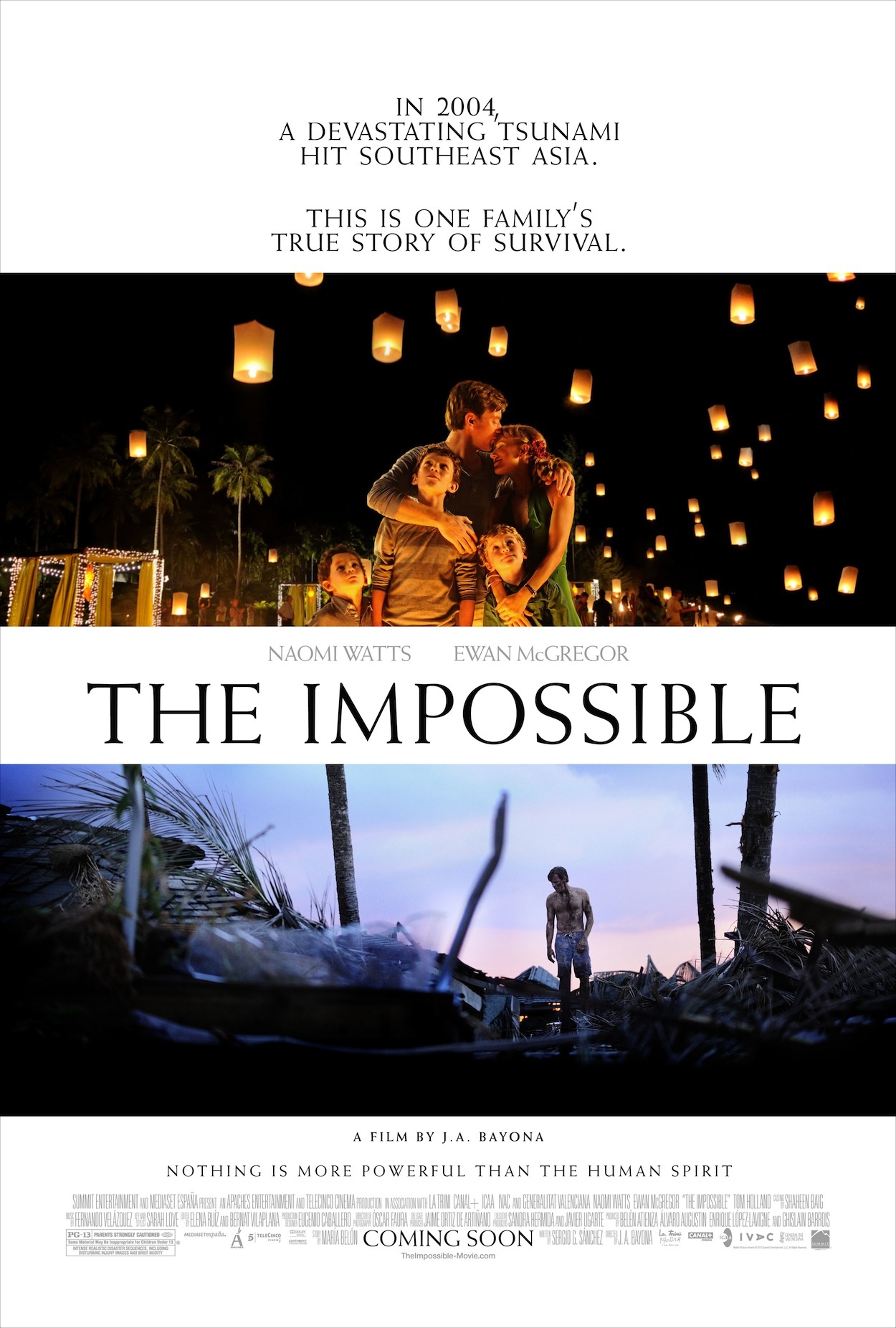 Based on harrowing true events, The Impossible is a story of unique horror — the extreme fear of trying to locate family members after experiencing a natural disaster. The film is based on a Spanish family who experienced the 2004 tsunami in Thailand, and are now portrayed in the film by Naomi Watts, Ewan McGregor, and impressive new young actor Tom Holland.
I sat down with director Juan Antonio Bayona in an exclusive interview to discuss the movie while the director was in Chicago for last October's international film festival. Amongst many topics, we discussed his own experience with the film title, how Naomi Watts likes to be directed, and why he chose to cast Caucasian actors to play out a story that is inspired by the true events of a Spanish family.
Based on harrowing true events, The Impossible is a story of unique horror — the extreme fear of trying to locate family members after experiencing a natural disaster. The film is based on a Spanish family who experienced the 2004 tsunami in Thailand, and are now portrayed in the film by Naomi Watts, Ewan McGregor, and impressive new young actor Tom Holland.
I sat down with director Juan Antonio Bayona in an exclusive interview to discuss the movie while the director was in Chicago for last October's international film festival. Amongst many topics, we discussed his own experience with the film title, how Naomi Watts likes to be directed, and why he chose to cast Caucasian actors to play out a story that is inspired by the true events of a Spanish family.
The Impossible opens in Chicago on December 21.
It seems like the title of the film could have easily rang true for your experience with this film as a director. Were there any moments when you were making this movie that you felt you were in over your head? How did you maintain that confidence while working on such a large, emotionally vulnerable scale?
The title was kind of a joke at times - we were going to do the impossible. But the truth is that even though I had the feeling that I had shot my second and third film at the same time, because shooting this was like shooting two films, it was good. I really enjoyed it, and I really loved working with the actors, to be on set with them. The story is such a great story for me, to let people know what happened, and to make people believe what happened; it was a great pleasure at the same time.
A great part of the experience of "The Impossible" is the sound mixing. Did you have a big hand in that?
It's funny because I was very careful with how the audience senses the story, because you have to be very emotional. You have to be emotional because as a director there were no moments in the story where the characters think about what is happening. They do not have time to stop and think about it. The only moment that the characters will have time to think about what happened is the last sequence, when they are leaving Thailand. I thought, I am going to try to do an experience with the audience, and not let them think about it, just feel it, and then send them back home with no explanation, because this is what happened to those people, and let them think about their own interpretation about the film and their own life. The sound and the music and the colors, everything had to play a very important role in playing into the experience.
What kind of cues did your give your composer when it came to musically accompanying the difficult emotional events?
It's very difficult to talk about music, because it is all about the instinct. You hear a melody, and it is all about what the melody provokes in you. I start always with a melody, and I tell the composer, "This melody is about sadness, failure, guilt," so all of these feelings that people go through in the end. So we start with the melody. But the truth is that with the music we try to tell things that we can not tell with words. In the story like this, it is very important because the characters talk in a different language, or the emotion.
Naomi Watts provides a strong emotional horror to the movie, and with films like "Funny Games" or "Mulholland Drive" she is known for giving intensely physical dramatic performances. How does directing her work? Does she know where she is going? Or do you have to balance her mood?
I think we had a lot of trust in each other. We just let ourselves to being dragged by the story. We were surrounded at the time by reality, and were shooting in locations that sometimes the extras were real survivors, so you just let yourself being touched by it. And Naomi as an actress, she loves the director to push her to a limit, and once she is at a limit, to ask her for more. She really loves that. She really loves to get to places where she cannot go, just alone. I love that. I remember we were shooting nonstop, and we never said "Cut." First position, first position, first position. There were moments where she couldn't talk, and she couldn't breathe, and she loved that. And there were moments that as a director, rewarding moments, where you can see that line between fiction and reality just disappear. And she loves that. She loves to take risks, she loves to just let herself drawn by the situation. She was amazing.
Did you do multiple takes often?
All the time. We did a lot of improvisation on set, so it was just an epic, and you have to be very prepared, but as a director, you want to break that. You do your homework, you get to the set, you get your take, but once you get a good take, now then you start to ask for more. "Okay, we did that. But, what else can we get?" And this is for me the most exciting moment in the process of making the film. The moment in which she is being dressed up by these Thai women, she just let herself go. We were shooting in a real village with real Thai women, they were not professional actors, and they just take care of her like she was really wounded. These happy accidents happen constantly on set, because we're trying to push all of the elements to these things to happen.
Another impressive performance in the film comes from newcomer Tom Holland. Your appreciation for him, and young actors, seems to be a driving theme in the film - the children are seen as equal to adults.
In the case of Tom Holland, I worked with him the same way that I did with Naomi. Of course, he had his chaperon and his teacher, but in terms of directing him, it was the same way. He has been playing "Billy Elliot" since he was eleven years old, and he has this discipline that you learn in the theater. So he was very responsible. And he is an extraordinary actor. He was able to get into the moment, and every time that I said cut, he was playing again with the other kid actors. And I love that he is able to work as a professional actor. But at the same time, he is a 13-year-old boy, and he is able to keep the innocence of a kid, and that played a major role in his performance. He was dealing with all of these emotions, but also watching them from a very interesting point of view.
I hate to ask, but I'm curious - what were your thoughts behind casting white actors like McGregor and Watts for a story based on a Spanish family?
I kept reading about "Why this white family?" and I think, one of the things in the story is the privilege. The audience will go to the theater and go home, and I want to really make them feel the experience, and really feel what it is like to be there, and to have a second chance like these characters, and think about it. This is what I like about movies, they teach you things. You need a second chance. This is what I like about the story, you have these people, and they have a second chance. And there is a lot of suffering through this second chance, and there is a lot of suffering in survival.
Has there been a lot of backlash to it? Have you had to answer a lot to it?
It's all the time, or even the way that we talk about Thai people, or talk about it like, "You are the Westerner," telling them how they suffer. Of course they suffer. And no one is nice in the film, you don't need to kill anybody to talk about that. It's all about people. Once the water arrives, the nationalities disappear, the social lives disappear, everything. All of the superficial layers disappear. In the end there is privilege, but there is a lot of suffering in privilege, and I want the audience to feel that. "Now you go back home, but think about what you saw."
Quick Questions with J.A. Bayona
What did you have for breakfast this morning? White eggs. Fruit.
If you could be someone else for 24 hours? Superman. I do movies because of Superman. The first memory of my life is a shot from Superman. I was 3 years old. It's the shot when you can see Christopher Reeve fly for the first time. That tells you a lot about my life. I dressed up as him all the time, as a kid, not anymore.
Age of first kiss? 13? 12? I don't know. 14? Something like that.
